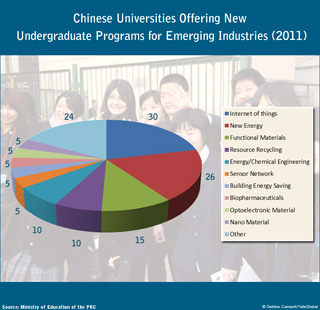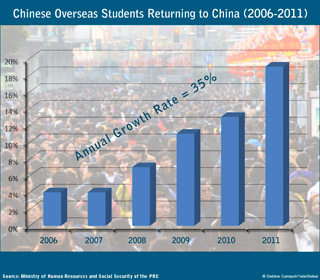Beyond Factory Floor: China’s Plan to Nurture Talent
Beyond Factory Floor: China’s Plan to Nurture Talent

BEIJING: The world’s most populous nation finds itself in the paradoxical position of a talent shortage. According to the PricewaterhouseCoopers 2012 CEO survey, more than 60 percent of CEOs in China found it hard to recruit appropriately skilled talent, while a survey of Chinese Academy of Social Sciences showed that 17.5 percent of 6.6 million college graduates in 2011 were jobless 6 months after graduation. To remedy this mismatch China has launched an ambitious plan not only to step up training workers and but also open doors to overseas talent.
During the past 20 years, the nation’s talent strategy focused on increasing higher-education enrollment and R&D investment. Nevertheless, enrollment in higher education climbed for the population aged 18 to 22, nearly tripling during the past 10 years, reaching 27 percent in 2011. And the nation built a R&D team of more than 1.6 million staff. This contributed to China's competitiveness in some academic research and technology fields, like aerospace and genetics. However, China is left behind in business, innovation, culture and social welfare fields.
China is determined to transition from the world’s manufacturing hub to a global leader in innovation. Talented people are needed in every industry sector, along with entrepreneurs, civil servants, social works and even cultural leaders. According to the National Outline for Medium- and Long-Term Talent Development (2010-2020) plan, China aims to increase its talent pool from the today’s 114 million to 180 million people by 2020.
To achieve the goal, the government is striving for a more open system, encouraging cooperation among industries, universities, official agencies and cross-border institutions.
For example, the Ministry of Education has taken steps to reform the higher-education system to meet industry needs.

Last year 140 domestic universities began to offer new undergraduate programs devoted to emerging industries, including the internet, alternative energies and resource recycling. Universities also enhanced offerings for professional master’s degrees, which emphasize business practice over academic research. Before 2010, there were only 19 categories of such programs in China. In 2010, 19 new categories were created, including journalism and communication, pharmacy and engineering management. Among master’s degrees awarded, the share for professional master’s degrees is expected to increase from 30 percent to 50 percent by 2015. (Figure 1)
Skilled labor is also indispensable to the industry sector. Plans are underway for 1200 education facilities – or “talent incubators” – for training technicians to be built in major cities by 2020. In addition, the Chinese government is to build 1000 in-house training workshops in companies by 2020, where senior skilled workers can teach new comers and improve techniques together. According to another Medium- and Long-Term Plan on Developing High-Skilled Talent, issued in 2011, China will have 140 million skilled factory workers with official certificates by 2020, 28 percent of whom will be at technician or senior technician levels, the top two of five levels.
Meanwhile, China decided to foster entrepreneurship and help local companies grasp global opportunities. The National Outline for Medium- and Long-Term Talent Development (2010-2020) aims to cultivate 100 strategic entrepreneurs who can lead Chinese firms into the ranks of the world’s top 500 companies by 2020. Executives in China’s top 500 companies will be provided with government-sponsored international training courses. Furthermore, striving to improve management quality, state-run companies are opening doors to global talent. By 2020, 50 percent of executives in state-owned enterprises will be recruited by competitive job postings rather than administrative appointment.
In its pursuit of economic growth, China began to realize the value of soft power, as described by Chinese Premier Wen Jiabao last year, "The strengths of a country lie not only in its economic power, but also in the qualities of its citizens, the level of cultural development and ethic rules."
In the next 10 years, the government will fund 2000 leading representatives in philosophy, social science, publishing, culture, art and heritage-protection areas. Meanwhile, more financial support will be provided to students majoring in social science and philosophy to study abroad. In 2011, the China Scholarship Council sponsored 13,690 Chinese students to study abroad, with a third of them in the fields of social science and philosophy.
To improve society’s well-being, China plans to build a capable team of civil servants and social workers. Higher standards will be imposed on the civil-servant hiring. By 2020, more than 85 percent of all government officials will at least have bachelor’s degree. At the same time, recruiting channels for civil servants will be widened. For instance, Guangdong Province, China’s manufacturing mainstay, announced selection of about 3700 civil servants from a pool of migrant workers, rural residents and social workers in 2012. To enhance public-sector efficiency, China aims to set up 300 training centers for social workers, increasing the number of social workers from the current 200,000 to 1.45 million in 2020.
Moreover, the government is introducing new measures to attract talent from overseas.
China has built more than 160 high-tech business incubators countrywide, enticing 20,000 Chinese who studied overseas to return and start business. Another 50 incubators will be added by 2015. In 2011, the total number of returned Chinese students studying abroad was 186,200, up near 40 percent from 2010. The recruitment of senior professionals overseas is mainly carried out through the “1000-Talent Plan” initiated in 2009. It’s attracted notables like China’s best-selling playwright Liu Liu, renowned pianist Xu Zhong and molecular biologist Shi Yigong. A 12th Five-year Plan for Returning Overseas Chinese Talents, released in 2011, has set a goal of attracting at least 500,000 Chinese overseas students and scholars from before 2015. (Figure 2)
China is also crafting policies to put out a welcome mat for foreign experts willing to work in China. "This year, China will expend more effort on solving issues concerning the visas and residency of high-level overseas talents... creating favorable policies for them in social insurance, taxation, medical services, their children's education and academic funding, and other areas," said Yin Weimin, Minister of Human Resources and Social Security. The 1000-Foreign Experts Plan launched in 2011 announced that the central government will subsidize foreign experts working in China with RMB 1 million per person, while those engaged in basic research will be granted up to RMB 5 million more in research funds. By February, 214 experts from countries like the United States and Japan have applied for the project, including specialists in laser, functional materials and other high-tech areas.
China is making significant strides toward nurturing its talent base. Not just China but the entire world will benefit from an expanded pool of talent. Despite the government’s ambitious plans, though, the foremost challenge is to ensure enough incentives for universities, enterprises and other participants to share costs and risks. For example, the government can only fund for a minority of those talent projects. The emerging industries are still in the early stage of development and can’t provide enough job opportunities or attractive compensations for graduates, which may discourage colleges and students from entering those fields.
China – like the US, Europe and Japan – still has a long way to go in matching appropriate talent to secure jobs.
